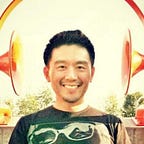The Way of Taiko
Composer Byron Au Yong has worked with six taiko groups…
“Taiko is more than a loud drum,” says Masato Baba.
We speak about Heidi Varian’s book The Way of Taiko, published by Stone Bridge Press. Varian is a disciple of Seiichi Tanaka, who founded San Francisco Taiko Dojo in 1968. She was a runway model from Iceland who started studying at Taiko Dojo in the 1980s. Her book is influenced by Tanaka’s austere form of training.
Inside the book cover is an ad for The Spirit of Taiko DVD, which features three generations of North American taiko performers: Tanaka, Kenny Endo and Baba.
Baba sits shotgun while Shoji Kameda drives. Kristofer Bergstrom sleeps in back.
“We had a late start,” Baba laughs.
They are on I-5 heading north from Los Angeles to the Bay Area to rehearse with Kelvin Underwood in preparation for a show by their quartet On Ensemble at The Triple Door in Seattle.
Speaking with them by telephone, I thumb through The Way of Taiko looking for photos of On Ensemble, but find none.
“The book should be called A Way of Taiko rather than The Way of Taiko,” says Kameda. “Tanaka-sensei’s training is old school in the best possible way. He felt pressure to represent a rigid mindset.”
Varian continues this mindset by tracing the path of taiko as an “ancient sacred practice in Japan” to her martial arts style training at Taiko Dojo. Her appealing, glossy, square-shaped book fits easily between my palms.
As I read, the book’s construction starts to come apart at the seams. Pages fall out and I worry that I will lose the correct order of taiko immersion that Varian describes.
Baba interrupts my fumbling, “The path of my parents (drummer Jeanne Aiko Mercer and saxophone musician Russel Baba) was very different than what they learned from Tanaka-sensei.”
“Jeanne and Russel took taiko and made it their own way back in the day.” Kameda explains.
After studying with Tanaka, Mercer and Baba moved to Mt Shasta in the 1970s. Along with raising their son, they started Shasta Taiko. Kameda, Baba’s next-door neighbor, started playing taiko with them at age eight.
“When I first started taiko, I was not into fusion at all. I thought taiko was a fixed tradition that had been around for thousands of years.” Kameda says.
Bergstrom, now awake, adds, “I had this naive Karate Kid image of taiko. When I went to Japan, there was no ‘wax on, wax off’ training.”
On Ensemble’s sound is an ongoing re-imagining of taiko music with their personal mix of indie rock, electronica, jazz, hip-hop, and other influences.
“This is the way identity and culture really work.” Kameda comments. “When reinvention stops happening the art becomes stagnant.”
Baba continues, “I want to make the best music I can. At school shows we ask the kids ‘What does taiko mean?’ Before, they’d answer ‘drums.’ Now, they say ‘music’.”
Original article published in the International Examiner, Vol. 35, № 10, on May 21, 2008, page 13. See IE Archives at iexaminer.org/archives
